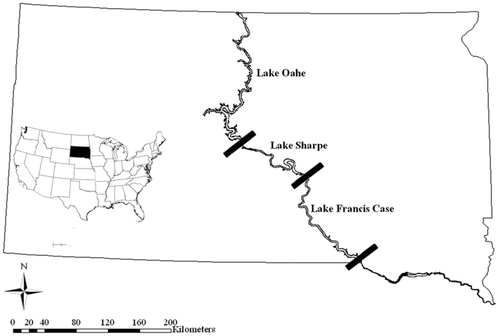Abstract
In an effort to improve size structure of smallmouth bass (Micropterus dolomieu) in Lake Sharpe, a large Missouri River impoundment, the South Dakota Department of Game, Fish and Parks instituted 2 protected slot limits: restricted (305–457 mm) beginning in 2003 and relaxed (355–457 mm) beginning in 2008. We examined the effects of these regulations on smallmouth bass harvest and population characteristics and compared creel and population trends of Lake Sharpe smallmouth bass to adjacent reservoirs where smallmouth bass harvest was not regulated by length limits. Prior to the slot limit, the majority of the smallmouth bass harvest from Lake Sharpe was for individuals 250–400 mm in length (P < 0.001). Estimated harvest after regulation implementation was higher for smallmouth bass 250–350 mm (P < 0.001). Additionally, an increase in proportional stock density–preferred (PSD-P), number >355 mm, and angler catch of trophy smallmouth bass was observed, suggesting an effective regulation. However, a before-after-control-impact (BACI) study design and analysis indicated changes in size structure were observed in abutting Lakes Oahe and Francis Case, suggesting a Missouri River system-wide affect was likely responsible for observed population changes. Because of the lack of biological support and the negative feedback by anglers, the protective slot limit regulation was removed from Lake Sharpe in 2012. Further, when considering length limit regulations, we recommend gathering data on similar “control” systems in an effort to document changes resulting solely from the impacts of the regulation.
Anglers have long been attracted to the sport fishing opportunities provided by black basses (Micropterus spp). Since the early 1980s, the number of anglers targeting black bass has increased (Schramm et al. Citation1991, Newman and Hoff Citation2000) and, subsequently, so has management and research of these species (Schramm et al. Citation1995, Weathers and Newman Citation1997). Smallmouth bass (Micropterus dolomieu) are native to east-central North America, but since the mid-1800s their range has expanded to include much of North America, England, Europe, Russia, and Africa (Scott and Crossman Citation1973). Smallmouth bass are native to the northeast region of South Dakota (Hoagstrom et al. Citation2007) but were introduced to the Missouri River reservoir system in the 1980s to provide new angling opportunities (Milewski and Willis Citation1990, Berry and Young Citation2004).
Regulations are often implemented to alter smallmouth bass population demographics to meet angler demands. The most common regulations implemented on smallmouth bass are minimum length limits (Austen and Orth Citation1988), which are intended to promote increased size structure, higher abundance, higher or consistent recruitment, or improved angler catch rates (Paragamian Citation1984, Lyons et al. Citation1996). However, size structure, growth, condition, and angler catch rates are sometimes negatively influenced by minimum length limits (Kauffman Citation1985, Austen and Orth Citation1988). A variety of reasons have been proposed for the ineffectiveness of smallmouth bass regulations, including noncompliance with regulations. For instance, 33% of harvested smallmouth bass were less than the 305 mm minimum length limit at the New River, West Virginia (Austen and Orth Citation1988), likely reducing the effectiveness of the minimum length limit. Additionally, hooking mortality was assumed to be high, increasing the total mortality of sub-legal fish.
Protective slot limits have been implemented to improve size structure by allowing the harvest of smaller fish while protecting and sustaining larger fish (Buynak and Mitchell Citation2002). This regulation promotes harvest and can be used in places where consumptive users are common. Few slot limit regulations have resulted in desired population changes after implementation, however, particularly for black basses (Eder Citation1984, Smith and Kauffman Citation1991, Buynack and Mitchell Citation2002).
In 2001, the South Dakota Department of Game, Fish and Parks (SDGF&P) found that >56% of smallmouth bass longer than 300 mm caught from Lake Sharpe, a large Missouri River impoundment, were harvested (Johnson et al. Citation2002). Subsequently, SDGF&P instituted a 305–457 mm protected slot limit for smallmouth bass in 2003 and later amended the regulation to a 355–457 mm protected slot limit in 2008. The regulation was intended to improve size structure of smallmouth bass while providing angler opportunities for consumptive use. Our objectives were to examine the effects of the protected slot limit on smallmouth bass harvest and population characteristics in Lake Sharpe and to evaluate responses of angler harvest and smallmouth bass population trends to upstream and downstream Missouri River reservoirs. We also attempted to separate the impacts of the protected slot limit from natural phenomena.
Methods
Study locations
This study was conducted in 3 large Missouri River impoundments located in South Dakota. Lake Sharpe, located in central South Dakota extends from Oahe Dam to Big Bend Dam and is the smallest of the 3 study reservoirs (). Lake Sharpe has a surface area of ∼25,000 ha with a mean and maximum depth of 10 m and 24 m, respectively. The most upstream reservoir, Lake Oahe, is located in north-central South Dakota and has a surface area of 110,000 ha, mean depth of 18 m, and maximum depth of 63 m. Lake Francis Case is also located in central South Dakota, immediately downstream from Lake Sharpe, and extends from Big Bend Dam to Fort Randall Dam. It has a surface area of ∼32,000 ha and a mean and maximum depth of 15 and 43 m, respectively.
Lakes Oahe, Sharpe, and Francis Case have diverse fish assemblages. Walleye (Sander vitreus) is the most sought after sportfish, while other common sportfish include smallmouth bass, sauger (Sander canadensis), rainbow trout (Oncorhynchus mykiss), Chinook salmon (Oncorhynchus tshawytscha; lakes Oahe and Sharpe), northern pike (Esox Lucius), channel catfish (Ictalurus punctatus), yellow perch (Perca flavescens), white bass (Morone chrysops), and white crappie (Pomoxis annularis). Primary prey resources include rainbow smelt (Osmerus mordax) and gizzard shad (Dorosoma cepedianum), but spottail shiners (Notropis hudsonius), lake herring (Coregonus artedi), and emerald shiners (Notropis atherinoides) are also present.
Creel estimates
Angler use and sport fish harvest surveys conducted on Lake Oahe and Lake Sharpe prior to 2003 were patterned after a study designed by Schmidt (Citation1975). Sampling included aerial boat and shore angler counts along with angler interviews. Flight and interview dates were selected using a stratified random design based on the assumption of differential levels of fishing pressure for weekdays, weekend days, and holidays. Lake access areas selected for angler interviews were assigned using a stratified random design. For a more detailed description of aerial count, angler interview, and data expansion techniques, see Stone et al. (Citation1994) and Fincel et al. (Citation2012a).
Beginning in 2003, a bus route survey design (Jones and Robson Citation1991) replaced aerial counts on Lake Sharpe to increase the statistical reliability of the pressure estimates. For a more detailed description of Lake Sharpe creel surveys, see Fincel et al. (Citation2012b). On Lake Francis Case, a bus route creel survey design (Jones and Robson Citation1991, Stone and Sorensen Citation2001, Soupir and Brown Citation2002) has been conducted since 2000 to estimate angler use and harvest. Similar to Lakes Oahe and Sharpe, estimates of angler catch and harvest were applied to pressure counts to determine lake-wide estimates. For a more detailed description of Lake Francis Case creel surveys, see Sorensen and Knecht (Citation2010).
Daytime (sunrise to sunset) creel surveys were conducted from 1 April 2001 through 30 September 2011. Information collected during angler interviews included trip length, type of fishing, targeted species, number in angler party, number of fish of each species harvested and released, and lengths of smallmouth bass harvested by anglers. Anglers were asked questions about satisfaction, preferences, attitudes and whether or not they were in favor of the current smallmouth bass regulation on Lake Sharpe. A complete list of satisfaction, attitude, and preferences can be found in Fincel et al. (Citation2012a, Citation2012b), Longhenry et al. (Citation2010, Citation2011), and Sorensen and Knecht (Citation2010).
Smallmouth bass field surveys
Smallmouth bass were sampled during annual SDGF&P standard coolwater fish population surveys conducted in August. Sites (Lake Oahe n = 9; Lake Sharpe n = 6; Lake Francis Case n = 9) were separated spatially into upper, middle, and lower zones of each reservoir. At each site, 3 gill nets were set overnight (∼20 h) and placed on the bottom within depth zones of 0–30 m and 30–60 m (if available), totaling 3–6 nets per site. If part or all of the gillnet was unfishable due to wind or wave action, the partial catch in that net was disregarded to prevent influencing estimates of catch rates. Gillnets were constructed of multifilament nylon and were 91 × 2 m, with 15 m panels of the following mesh sizes: 13, 19, 25, 32, 38, and 51 mm (bar length). Effort was kept constant (within a reservoir) for the study period. Collected smallmouth bass were weighed (g), measured (mm, total length), and sagittal otoliths were removed from a subsample of fish at the time of capture. Each otolith was aged independently by 2 experienced readers. Any discrepancies in smallmouth bass ages resulted in a third reader review, and if no consensus was reached, the specimen was removed from the dataset.
Analyses
The pre-regulation period (1998–2002) encompasses a time period when size restrictions were not in place on any of the reservoirs. A 305–457 mm protective slot limit was implemented in 2003 and later amended to 355–457 mm in 2007. Multiple years would likely be necessary before size structure, growth, and condition would change at a level large enough to detect after regulation implementation. We therefore compared populations only after a slot limit was in place for a minimum of 6 years, comparing 2 time periods designated pre-regulation (1998 through 2002; no regulations) and post-regulation (2009 through 2011; protective slot limit on Lake Sharpe). Lakes Oahe and Francis Case did not have smallmouth bass size restrictions at any time during the duration of the study. A 5 smallmouth bass per angler per day bag limit (statewide regulation) was in effect for all reservoirs throughout the study period.
We examined differences in length-frequencies of angler harvested smallmouth bass from pre-regulation, during early-regulation years (2004 through 2007), and late-regulation (2008 through 2011). This was the only factor analyzed soon after implementation, with the goal of evaluating regulation noncompliance. We calculated percent harvest for 50 mm smallmouth bass size classes (200–249, 250–299, 300–349, 350–399, 400–449, and ≥450 mm), transformed (arcsine square root) to meet normality requirements. We then used analysis of variance (ANOVA) to compare harvest between size classes. If significant differences were detected, we used a Tukey significance test to determine which size classes were different within a specific regulation period. We compared smallmouth bass catch rates (smallmouth bass caught per hour per angler), harvest rates (smallmouth bass harvest per hour per angler), number of smallmouth bass harvested and angler trips (measure of effort) in all 3 reservoirs using 2-way ANOVAs. Comparisons of creel information were not transformed because data met normality assumptions (Shapiro-Wilk; P > 0.05).
A before-after-control-impact (BACI) study design (Underwood Citation1994) was used to assess protected slot limit regulation on smallmouth bass size structure (proportional stock density–preferred [PSD-P]), gill net catch of smallmouth bass >355 mm, and condition (relative weight; Wr) of smallmouth bass (see Anderson and Neumann Citation1996 and Kolander et. al Citation1993 for calculations of PSD-P and Wr). This approach comprises replicated temporal and spatial sampling of control sites and a putatively impacted site to test for the effects of a disturbance (Underwood Citation1994).
To evaluate the effects of a disturbance in the BACI approach, asymmetrical analysis of variance is used. In this analysis, contrasts of the impacted versus control locations and their interactions with time were obtained from the variation among all locations and their interaction with time (Underwood Citation1992, Citation1994). In summary, a sequence of tests (explained in detail in Underwood Citation1993) was conducted to detect if a disturbance (i.e., slot limit regulation in this study) results in a change in pattern of response variable (e.g., size structure) different from that occurring naturally in an undisturbed location (i.e., upstream and downstream reservoirs with no length restrictions). Three results are possible with the outcome of this analysis, including no impact, a pulse impact, and a press impact (Underwood Citation1992). No impact indicates that the regulations did not cause a different pattern of change in Lake Sharpe compared with Lakes Oahe and Francis Case. A pulse impact, is a short-term change in pattern of the response variable in Lake Sharpe that returns to a pattern similar to that of Lakes Oahe and Francis Case after time. A press impact is a sustained pattern of difference (Underwood Citation1992, Citation1994). We used the response variables smallmouth bass PSD-P (arcsine square-root transformed), total gill net catch of smallmouth bass >355 mm, and smallmouth bass condition (Wr) before and after the protective slot regulation was implemented.
Finally, we predicted increased harvest on smaller smallmouth bass (i.e., below the slot limit), reducing their density and resulting in faster growth of larger smallmouth bass because of reduced food competition with smaller smallmouth bass for similar food resources (e.g., gizzard shad; Wuellner et al. Citation2010). To determine if larger smallmouth bass grew faster, we compared length-at-age for age-6, age-7, and age-8 smallmouth bass from 2003 to 2010. We used ANOVA to determine if mean length of the fish within the protected slot limit has increased since the implementation of the regulation.
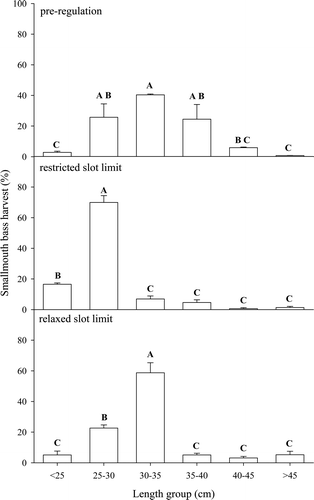
Results
During the pre-regulation time period in Lake Sharpe, smallmouth bass harvest for fish ranging in length from 250 to 400 mm was significantly more than fish <250 mm and >400 mm (F5,6 = 15.76; P = 0.002; ). After implementation of the restricted slot limit, harvest was focused on smallmouth bass <300 mm (F4,9 = 93.35; P < 0.001; ). After the relaxed slot limit was implemented, harvest again was skewed to the lower end of the slot limit () and was highest for fish 250–350 mm (F5,18 = 36.39; P < 0.001).
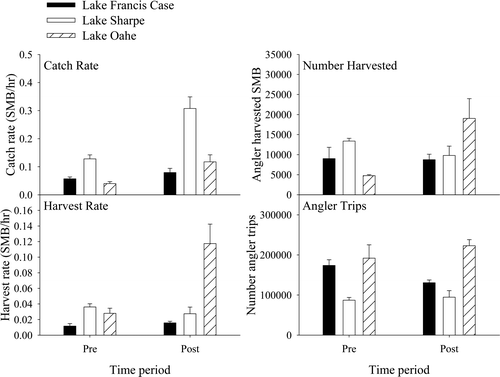
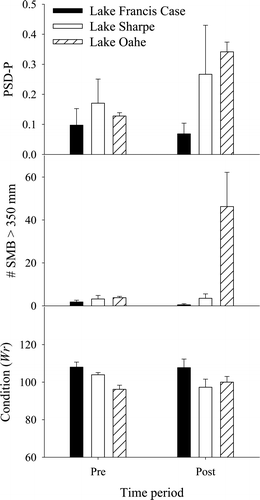
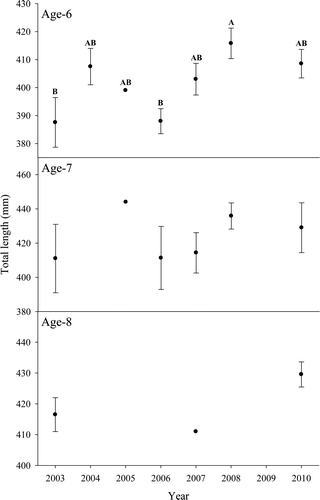
Table 1 Asymmetrical analyses of variance results comparing PSD-P, number of smallmouth bass >355 mm caught during standard surveys and smallmouth bass condition (Wr; 1998 through 2010) from Lake Sharpe, SD (protective slot limit enacted in 2003 and 2008) and 2 control reservoirs (no size restrictions; Lake Oahe and Lake Francis Case, SD). Bold type indicates a statistical significance (α = 0.10).
Noncompliance with regulations was observed from 2004 to 2006 after the 305–457 mm slot limit was implemented; nearly 15% of smallmouth bass harvest was fish 300–450 mm. When the slot limit was relaxed in 2008, noncompliance of smallmouth bass harvest from within the slot limits decreased to 8% for 2009–2011.
From 2003 through 2010, the number of smallmouth bass >350 mm collected annually during standard surveys was 116–299, 35–200, and 4–17 on Lakes Sharpe, Oahe, and Francis Case, respectively. Despite the large differences in surface area among the 3 reservoirs, there was no significant difference in number of smallmouth bass harvested between the reservoirs (F2,21 = 0.049; P = 0.952), but there was a significant difference in system-wide smallmouth bass harvest over time (F2,21 = 6.86; P = 0.005) with a significant interaction (F4,21 = 5.05; P = 0.005). There was no difference in total smallmouth bass harvest during any of the time periods on Lakes Sharpe or Francis Case (). The smallmouth bass harvest rate was only significantly different between time periods within Lake Oahe (F2,7 = 8.405; P = 0.010).
The results of the asymmetrical analysis of variance suggest that although size structure (PSD-P) and the number of smallmouth bass >355 mm did significantly increase from before to after the slot limit was implemented, the protective slot regulation was not likely the reason for the pattern of change in size structure in Lake Sharpe (, ). Increases in PSD-P and number of smallmouth bass >355 mm were also observed in Lakes Oahe and Francis Case during the regulation time periods. Smallmouth bass condition was different among reservoirs; however, it remained unchanged throughout the study period (). The patterns of change in size structure, number of smallmouth bass >355 mm and relative weight were similar in all 3 reservoirs (), suggesting that environmental influences rather than the slot limit were responsible for the changes in smallmouth bass population characteristics.
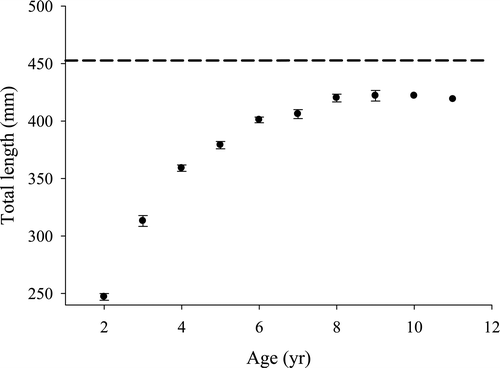
Total length of age-6 smallmouth bass in Lake Sharpe was greater in 2008 compared to 2003 or 2006 (F5,58 = 3.92; P = 0.004; ). There was no difference in total length for either age-7 (F4,13 = 1.11; P = 0.393) or age-8 (F1,9 = 3.69; P = 0.097) smallmouth bass from 2003 through 2010. Additionally, when examining length at age for smallmouth bass in 2009, smallmouth bass achieved a mean maximum length of 400–425 mm and did not generally surpass that length (); thus, the majority of fish in the system were not able to grow past the upper threshold of the protected slot limit (457 mm).
Discussion
Initial interpretation for smallmouth bass in Lake Sharpe suggested improvement of the smallmouth bass fishery following the implementation of the protective slot limit regulation. Smallmouth bass >355 mm were more prevalent in the standard surveys, angler catch rates increased, and angler harvest of smallmouth bass >457 mm increased slightly. Superficially, smallmouth bass size structure seemed to improve following regulation implementation; however, examining trends in the reservoirs both upstream and downstream of Lake Sharpe negated the suspected regulation effects. In Lake Oahe, directly upstream of Lake Sharpe, we also observed increased smallmouth bass harvest, harvest rates, PSD-P, and gill net catch of smallmouth bass >355 mm, but to a greater extent compared to downstream reservoirs. We also saw similar but less dramatic trends in Lake Francis Case, directly downstream of Lake Sharpe. Ultimately, similar to slot limit regulations on smallmouth bass in other populations in the United States, little direct effect could be attributed to the regulation itself (Smith and Kauffman Citation1991, Buynack and Mitchell Citation2002).
For slot limits to effectively increase growth of desired sport fish, harvest below the slot limit must be large enough to effectively reduce biomass of the smaller fish (Eder Citation1984, Buynack and Mitchell Citation2002). Harvest of smallmouth bass from Lake Sharpe was highest prior to the regulation implementation and decreased substantially post-regulation. This decline in harvest following regulation implementation is not novel (Kraai Citation1993), although it likely contributed to observed no-growth changes. Additionally, compared to the high walleye harvest observed on Lake Sharpe through the same time period (Fincel et al. Citation2012b), angler exploitation (percent of population harvested yearly) of the smallmouth bass population is likely not approaching the harvest needed to increase smallmouth bass growth. In many systems, voluntary catch and release of black basses is commonplace and can limit regulation effectiveness (Iserman et al. Citation2013). Largemouth bass for example, need non-slot exploitation of 70% to increase growth of the remaining fish (Eder Citation1984). Exploitation of 36% was not high enough to increase smallmouth bass growth during a slot limit regulation in the Shenandoah River (Smith and Kauffman Citation1991). In the main-stem Elkhorn Creek, Kentucky, low harvest was also identified as the primary reason for no improved growth of smallmouth bass following a slot limit regulation (Buynack and Mitchell Citation2002).
Effectiveness of harvest regulation for any one species is partly dependent on the response of competing species and is another potential reason for our observed results. For instance, in addition to the low smallmouth bass harvest during the regulation period, potential competition with walleye needs to be considered. In Lake Sharpe, like other Missouri River impoundments, a walleye population exists, and harvest routinely surpasses 125,000 walleye per year (Fincel et al. Citation2012b). Generally, diet overlap is low between these 2 species (Poe et al. Citation1991, Lott Citation1996, Vander Zanden et al. Citation1997); however, a recent diet study revealed extensive overlap for Lake Sharpe walleye and smallmouth bass (Wuellner et al. Citation2010). Direct competition between the 2 species was deemed lacking because of the abundant primary prey; however, because of the high diet overlap, the goal of increasing growth and/or size structure through smallmouth bass harvest would likely only succeed if a concomitant reduction in walleye (or other species that share the same primary prey) occurs.
Although total harvest was low, Lake Sharpe exhibited relatively high rates of noncompliance after slot limit initiation. Generally, slot limit regulations have high noncompliance rates (Mayers Citation1988, Mosher Citation1991, Pierce and Tomcko Citation1998), often attributed to poor angler awareness, but we believe angler awareness of the regulation was high. One striking difference observed with this regulation compared to other regulations set by SDGF&P was angler acceptance; only 50% of the anglers were in support of the slot limit (). A key component to the effectiveness of a protected slot limit is angler acceptance, which was not achieved on Lake Sharpe after 9 years. Building awareness and angler acceptance is more difficult than enacting the regulation and undoubtedly aided in the observed noncompliance (Pierce and Tomcko Citation1998).
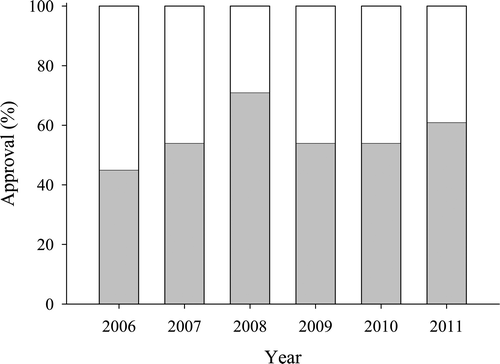
Walleye are the most sought after species in the Missouri River impoundments in South Dakota and comprise ∼85–90% of the targeted species in the system (Fincel et al. Citation2012a, Citation2012b, Longhenry et al. Citation2010). Thus, smallmouth bass are often a nontarget species and considered “by-catch” by many walleye anglers. Compliance or rule acceptance by smallmouth bass anglers could have been high, but compliance/acceptance of the anglers targeting walleye could have been poor (Glass Citation1984). We expected an increase in popularity of smallmouth bass angling following the regulation similar to that observed in other systems (Slipke et al. Citation1998), but unfortunately, acceptance and percentage of anglers targeting smallmouth bass did not follow expected trends (Fincel et al. Citation2012b).
Management implications
Initial analyses of the Lake Sharpe protective slot limit suggested the smallmouth bass protective slot limit met expectations set by the SDGF&P. Smallmouth bass population structure seemed to improve while allowing some harvest; however, the BACI analysis showed that these changes occurred throughout the Missouri River impoundments, while the slot limit applied only to one impoundment. Positive changes to smallmouth bass population demographics were observed (albeit varying in magnitude compared to Lake Sharpe) in upstream and downstream reservoirs, suggesting system-wide changes rather than the slot limit regulation was impacting the smallmouth bass population. These system wide changes, if in fact there were positive impacts, possibly masked the influences of the regulation; however, this analysis was not able to distinguish between these phenomena. We recommend setting up control lakes for future regulation evaluation because without the use of Lakes Oahe and Francis Case for direct comparisons, different conclusions would have been drawn for the effectiveness of protective slot limits for smallmouth bass in Lake Sharpe.
In the absence of direct evidence documenting a regulation as the main factor in population structure improvement, consideration for removal is warranted. Moreover, setting up lakes for direct comparisons proved crucial in the evaluation of this regulation, and we recommend similar evaluations when determining impacts of regulations on sportfish populations throughout the United States. Ultimately in Lake Sharpe, growth of smallmouth bass never exceeded the upper threshold of the slot limit; thus, the regulation was acting to protect an ageing population. Additionally, noncompliance rates were high, and acceptance of the regulation was never >75%. Following a review of population characteristics, creel results, and acceptance of the regulation, the smallmouth bass protective slot was removed from Lake Sharpe in 2012.
Acknowledgments
We thank G. Adams Jr., M. Barnes, B. Blackwell, K. Edwards, B. Hanten, J. Lott, D. Lucchesi, K. Potter, M. Smith, and J. Sorensen from the South Dakota Game, Fish and Parks; and B. Graeb, D. Willis, and M. Wuellner from the Department of Natural Resources at South Dakota State University. Any use of trade, firm, or product names is for descriptive purposes only and does not imply endorsement by the US Government.
References
- Adams G, Potter K, Edwards K, Hanten R. 2009. Annual fish population and angler use, harvest and preference surveys on Lake Sharpe, South Dakota, 2008. Pierre (SD): South Dakota Department of Game, Fish and Parks, Wildlife Division Report No. 09-06.
- Anderson RO, Neumann RM. 1996. Length, weight, and associated structural indices. In: Murphy BR, Willis DW, editors. Fisheries techniques,2nd ed. Bethesda (MD): American Fisheries Society. p. 447–482.
- Austen DJ, Orth DJ. 1988. Evaluation of a 305-mm minimum length limit for smallmouth bass in the New River, Virginia and West Virginia. N Am J Fish Manage. 8:231–239.
- Berry CR Jr, Young B. 2004. Fishes of the Missouri National Recreational River, South Dakota and Nebraska. Great Plains Res. 14:89–114.
- Buynak GL, Mitchell B. 2002. Response of smallmouth bass to regulatory and environmental changes in Elkhorn Creek, Kentucky. N Am J Fish Manage. 22:500–508.
- Eder S. 1984. Effectiveness of an imposed slot length limit of 12.0–14.9 inches on largemouth bass. N Am J Fish Manage. 4:469–478.
- Glass RD. 1984. Angler compliance with length limits on largemouth bass in an Oklahoma reservoir. N Am J Fish Manage. 4:457–458.
- Fincel MJ, Edwards K, Hanten R, Smith M, Potter K. 2012a. Annual fish population and angler use, harvest and preference surveys on Lake Oahe, South Dakota, 2011. Pierre (SD): South Dakota Department of Game, Fish and Parks, Wildlife Division, Annual Report No. 12–06.
- Fincel MJ, Potter K, Edwards K, Hanten R, Smith M. 2012b. Annual fish population and angler use, harvest and preference surveys on Lake Sharpe, South Dakota, 2011. Pierre (SD): South Dakota Department of Game, Fish and Parks, Wildlife Division, Annual Report No. 12–04.
- Hoagstrom CW, Wall SS, Kral JG, Blackwell BG, Berry Jr CR. 2007. Zoogeographic patterns and faunal changes of South Dakota fishes. Western N Am Naturalist. 67:161–184.
- Iserman DA, Maxwell JB, McInerny MC. 2013. Temporal and regional trends in black bass release rates in Minnesota. N Am J Fish Manage. 33:344–350.
- Johnson B, Hanten R, Lott J. 2002. Annual fish population and angler use, harvest and preference surveys on Lake Sharpe, South Dakota, 2001. Pierre (SD): South Dakota Department of Game, Fish and Parks, Wildlife Division, Annual Report.
- Jones CM, Robson DS. 1991. Improving precision in angler surveys: traditional access design versus bus route design. In: Guthrie D, Hoenig JM, Holliday M, Jones CM, Mills MJ, Moberly SA, Pollock KH, Talhelm DR, editors. Creel and angling surveys in fisheries management. Bethesda (MD): American Fisheries Society Symposium 12. p. 177–188.
- Kauffman J. 1985. Effects of a smallmouth bass minimum size limit on the Shenandoah River sport fishery. Proceedings of the Annual Conference of the Southeastern Association of Fish and Wildlife Agencies. 31:459–467.
- Kolander TD, Willis DW, Murphy BR. 1993. Proposed revision of the standard weight (Ws) equation for smallmouth bass. N Am J Fish Manage. 13:398–400.
- Kraai JE. 1993. Effects of minimum length limits on smallmouth bass in Meredith Reservoir, Texas. Proceedings of the Annual Conference of the Southeastern Association of Fish Wildlife Agencies. 31:695–701.
- Longhenry C, Potter K, Edwards K, Hanten R. 2010. Annual fish population and angler use, harvest and preference surveys on Lake Sharpe, South Dakota, 2009. Pierre (SD): South Dakota Department of Game, Fish and Parks, Wildlife Division Report No. 10–02.
- Longhenry C, Potter K, Edwards K, Hanten R. 2011. Annual fish population and angler use, harvest and preference surveys on Lake Sharpe, South Dakota, 2010. Pierre (SD): South Dakota Department of Game, Fish and Parks, Wildlife Division Report No. 11–07.
- Lott JP. 1996. Relationships between smallmouth bass feeding ecology and population structure and dynamics in lower Lake Oahe, South Dakota. Pierre (SD): South Dakota Department of Game, Fish and Parks, Fisheries Division Report No. 06–03.
- Lyons J, Kanehl PD, Day DM. 1996. Evaluation of a 356-mm minimum length limit for smallmouth bass in Wisconsin streams. N Am J Fish Manage. 16:952–957.
- Mayers DA. 1988. Effects of three years of minimum and slot length limit regulations for largemouth bass [master's thesis]. [Stevens Point (WI)]: University of Wisconsin.
- Milewski CL, Willis DW. 1990. A statewide summary of smallmouth bass sampling data from South Dakota waters. Pierre (SD): South Dakota Department of Game, Fish and Parks, Fisheries Report No. 90–09.
- Mosher T. 1991. A review of black bass length limits in Kansas state fishing lakes ten years after implementation. Pratt (KS): Kansas Fisheries and Wildlife Division, Comprehensive Planning Option, Project FW-9-p-10.
- Newman SP, Hoff MH. 2000. Evaluation of a 16-inch minimum length limit for smallmouth bass in Pallette Lake, Wisconsin. N Am J Fish Manage. 20:90–99.
- Paragamian VL. 1984. Evaluation of a 12.0-inch minimum length limit on smallmouth bass in the Maquoketa River, Iowa. N Am J Fish Manage. 4:507–513.
- Pierce RB, Tomcko CM. 1998. Angler noncompliance with slot length limits for northern pike in five small Minnesota lakes. N Am J Fish Manage. 18:720–724.
- Poe TP, Hansel HC, Vigg S, Palmer DE, Prendergast LA. 1991. Feeding of predaceous fishes on outmigrating juvenile Salmonids in John Day Reservoir, Columbia River. T Am Fish Soc. 120:405–420.
- Potter K, Edwards K, Adams G. 2008. Annual fish population and angler use, harvest and preference surveys on Lake Sharpe, South Dakota, 2007. Pierre (SD): South Dakota Department of Game, Fish and Parks, Wildlife Division Report No. 08–06.
- Potter K, Lott J. 2007. Annual fish population and angler use, harvest and preference surveys on Lake Sharpe, South Dakota, 2006. Pierre (SD): South Dakota Department of Game, Fish and Parks, Wildlife Division Report No. 07–09.
- Schmidt BR. 1975. Results and evaluation of an aerial creel survey technique on Lake Sharpe, South Dakota [master's thesis]. [Brookings (SD)]: South Dakota State University.
- Schramm HL, . 1991. The status of competitive sport fishing in North America. Fisheries. 16:4–12.
- Schramm HL, McKeown PE, Green DM. 1995. Managing black bass in northern waters: summary of the workshop. N Am J Fish Manage. 15:671–679.
- Scott WB, Crossman EJ. 1973. Freshwater fishes of Canada. J. Fish Res Board Can. 1984.
- Slipke JW, Maceina MJ, Travnicheck VH, Weathers KC. 1998. Effects of a 356-mm minimum length limit on the population characteristics and sport fishery of smallmouth bass in the shoals reach of the Tennessee River, Alabama. N Am J Fish Manage. 18:76–84.
- Smith PP, Kauffman JW. 1991. The effects of a slot size limit regulation of smallmouth bass in the Shenandoah River, Virginia. In: Jackson DC, editor. Proceedings of the first international smallmouth bass symposium. Starkville (MS): Mississippi State University, Mississippi Agricultural and Forestry Experimental Station. p. 112–117.
- Sorensen J, Knecht G. 2010. Annual fish population and angler use, harvest and preference surveys on Lake Francis Case, South Dakota, 2009. Pierre (SD): South Dakota Department of Game, Fish and Parks, Wildlife Division Report No. 10-13.
- Soupir CA, Brown ML. 2002. Comprehensive evaluation and modification to the South Dakota angler creel program. Pierre (SD): South Dakota Department of Game, Fish and Parks, Completion Report 02-10.
- Stone C, Riis J, Johnson B. 1994. Angler use and sport fishing harvest survey on Lake's Francis Case, Sharpe, and Oahe, South Dakota, 1992 and 1993. Pierre (SD): South Dakota Department of Game, Fish and Parks, Wildlife Division Report No. 94-9.
- Stone CC, Sorensen J. 2001. Annual fish population and angler use and sport fish harvest surveys on Lake Francis Case, South Dakota, 2000. Pierre (SD): South Dakota Department of Game, Fish and Parks, Annual Report 01-08.
- Underwood AJ. 1992. Beyond BACI: the detection of environmental impacts on populations in the real, but variable world. J Exp Mar Biol Ecol. 161:145–178.
- Underwood AJ. 1993. The mechanics of spatially replicated sampling programmes to detect environmental impacts in a variable world. Aust J Ecol. 18:99–116.
- Underwood AJ. 1994. On beyond BACI: sampling designs that might reliably detect environmental disturbances. Ecol Appl. 4:3–15.
- Vander Zanden MJ, Cabana G, Rasmussen JB. 1997. Comparing trophic position of freshwater fish calculated using stable nitrogen isotope ratios and literature dietary data. Can J Fish Aquat Sci. 54:1142–1158.
- Weathers KC, Newman MJ. 1997. Effects of organizational procedures on mortality of largemouth bass during summer tournaments. N Am J Fish Manage. 17:131–135.
- Wuellner MR, Chipps SR, Willis DW, Adams WE Jr. 2010. Interactions between walleyes and smallmouth bass in a Missouri River reservoir with consideration of the influence of temperature and prey. N Am J Fish Manage. 30:445–463.

